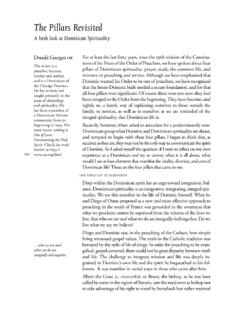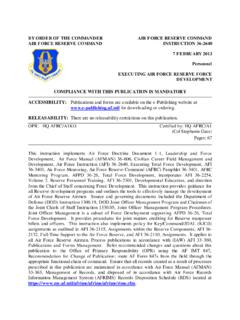Transcription of THE FOUR PILLARS OF JUSTICE BASED POLICING
1 THE four PILLARS OF JUSTICE BASED POLICING Listen and Explain with Equity and Dignity King County Sheriff Sue Rahr, Seattle Police Chief John Diaz, and Washington State Criminal JUSTICE Training Commission Director Joe Hawe 1 JUSTICE BASED POLICING Our current state of law enforcement can probably be best described with this statement: People don t care so much about crime stats; they care about how they re treated . This article will discuss why that matters and what we can do about it. Professor Tom Tyler of New York University has done extensive work in this area under the rubric of Procedural JUSTICE and Police Legitimacy. Simply stated this means that a critical and sometimes neglected part of law enforcement s legitimacy and effectiveness is impacted by the perception of fairness and JUSTICE by those we serve. This dynamic is especially important in minority communities.
2 It explains why, after three decades of dramatically falling crime rates, improved training, and widely used community POLICING strategies, public perception of police has not improved. JUSTICE BASED POLICING is a strategy to improve the quality and outcome of interactions between police and citizens while improving officer safety. Over time and across multiple interactions it strengthens community trust and confidence in the police and increases future cooperation and lawful behavior by citizens. JUSTICE BASED POLICING is not a new idea. It s not a program. It s not complicated. It s the way good cops have always done it. Rather than adding another layer of training and mandates to our current practices, it can be easily and logically integrated into everything we do by following the four basic principles represented by the LEED model: Listen and Explain with Equity and Dignity Listen Allow people to give their side of the story; give them voice, and let them vent.
3 Explain Explain what you re doing, what they can do, and what s going to happen. Equity Tell them why you are taking action. The reason must be fair and free of bias, and show their input was taken into consideration. Dignity Act with dignity and leave them with their dignity. By addressing these four critical human needs on every call, officers elevate the quality of the interaction and people are more likely to see police as helping rather than controlling. The result is improved officer safety and increased community trust. 2 In the Seattle area, recent high-profile incidents involving uses of force by and against the police have significantly heightened the issue of public perception of law enforcement. The need to build and strengthen trust and confidence between the police and the community is urgent. To address this pressing need Washington State Criminal JUSTICE Training Commission (WSCJTC) Director Joe Hawe, King County Sheriff Sue Rahr, and Seattle Police Chief John Diaz formed a unique and powerful partnership committed to incorporating JUSTICE BASED POLICING practices into the standard delivery of police services.
4 The WSCJTC provides training statewide to all new police recruits; as well as ongoing training for veteran officers, supervisors, and law enforcement leaders. The Seattle Police Department (SPD) and the King County Sheriff s Office (KCSO) are the two largest local police agencies in the state. These three partners reached out to the COPS Office and the National Institute of JUSTICE (NIJ) with a proposal to develop a JUSTICE BASED POLICING curriculum for line personnel. We proposed to work in coordination with The University of Illinois (U of I), Center for Public Safety and JUSTICE , where a COPS funded curriculum is being developed for organizational transformation to procedural JUSTICE . (The focus of that curriculum is to provide supervisors and leaders with the tools to prepare the culture in police agencies for JUSTICE BASED POLICING .) In February of 2011 the three Washington partners met with COPS Office Director Bernard Melekian, NIJ Deputy Director Ellen Scrivner, NYU Professor Tom Tyler, and other stakeholders in Seattle to discuss how to most effectively proceed with this initiative.
5 Sheriff Rahr and Chief Diaz agreed to assign their personnel to work with WSCJTC personnel to develop a curriculum and training strategies for line officers. Seattle University agreed to assist with the research and evaluation component for the line level curriculum. The Washington partners agreed to collaborate with U of I to ensure that the line curriculum aligns with U of I s organizational transformation curriculum. To successfully institutionalize JUSTICE - BASED POLICING into the culture of our police agencies we will take the following three steps: 1. First, ensure that leaders and supervisors understand and embrace the principles of procedural JUSTICE and police legitimacy - the foundation for JUSTICE - BASED POLICING . This will be accomplished by delivering the curriculum under development at U of I to build a culture that employs the LEED model in all internal police interactions.
6 (Fall 2011) 2. Shortly after the ISU curriculum is delivered, we will deliver the line officer curriculum for new recruits and for veterans attending in-service training at the academy. The line curriculum will go into depth about the principles and research related to procedural JUSTICE and police legitimacy. Each element of the LEED model will be fully explored through scenario- BASED adult learning methods. Additionally, 3 4 3. Throughout this entire development process, we will work with our community leaders to develop an effective community outreach and education campaign. We will share information about our culture change around JUSTICE - BASED POLICING and the role of community members. We will take steps to establish credible and reliable communication and partnership strategies so we can continually assess and build trust and confidence of the community.
7 Throughout the process, we will work closely with Seattle University Criminal JUSTICE programs to measure and analyze the perceptions of community members and police officers to gauge effectiveness of the training. BASED on those assessments, we will make adjustments along the way. JUSTICE BASED POLICING is the next evolution of an effective Community Oriented POLICING strategy. In order to fully engage the people we serve, we must have their trust and confidence. This relationship is built one interaction at a time. As we face a future with fewer and fewer police resources, we must increasingly rely on citizen cooperation and voluntary compliance with the law. The research is clear - as trust and confidence increases, so will cooperation with police and compliance with laws. We can t afford not to implement JUSTICE BASED POLICING for the sake of community safety and the safety of our officers.
8 References to Dr. Tyler s work on Procedural JUSTICE : Dr. Tom Tyler s web page at New York University. A four -Component Model of Procedural JUSTICE : Defining the Meaning of a Fair Process. Steven L. Blader and Tom R. Tyler, New York University Tyler, (1990). Why people obey the law. New Haven: Yale. Reissued with a new afterword: (2006). Princeton University Press. Tyler, , and Huo, (2002). Trust in the law: Encouraging public cooperation with the police and courts. : Russell-Sage Foundation. Final note On August 2, 2011 the COPS Office awarded a $400,000 grant to the KCSO/SPD/WSCJTC partnership to complete this project! It is our expectation that we will have a model to share with law enforcement agencies across the nation by the end of 2012.









